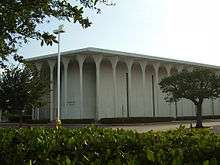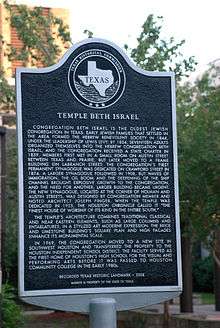Congregation Beth Israel (Houston)

Congregation Beth Israel of Houston, the oldest Jewish congregation in Texas, was founded in Houston in 1854.
History
|
Temple Beth Israel | |
|
Temple Beth Israel building, 1925–1967 | |
 Location in Texas  Congregation Beth Israel (Houston) (the US) | |
| Location | 3517 Austin St., Midtown Houston, Texas |
|---|---|
| Coordinates | 29°44′14″N 95°22′30″W / 29.73735°N 95.37496°W |
| Built | 1924 |
| Architect | Finger, Joseph |
| Architectural style | Moderne |
| NRHP reference # | 84001826[1] |
| RTHL # | 14339 |
| Significant dates | |
| Added to NRHP | March 1, 1984 |
| Designated RTHL | 1974 |
The congregation was founded in 1854 as an Orthodox Jewish kehilla and legally chartered in 1859.[2] The Orthodox Beth Israel Congregation in Houston opened in a former house that had been converted to a synagogue.[3] In 1874 the congregation voted to change their affiliation to Reform Judaism, sparking the foundation of Congregation Adath Yeshurun, now known as Congregation Beth Yeshurun.[2] Hyman Judah Schachtel was a past rabbi.
Beth Israel's Franklin Avenue Temple building was completed in 1874.[4][5] The temple was at Crawford Street at Franklin Avenue in what is now Downtown Houston. In 1908 the congregation moved into a new temple at Crawford at Lamar Street, in an area that was a Jewish community.[6] After the congregation left the Lamar site, the New Day Temple occupied it. As of 2016 The Grove at Discovery Green occupies the former Lamar site.[7]
A new temple at Austin Street and Holman Avenue was dedicated in 1925.[4][5] Originally it was considered to be a part of the Third Ward.[8]
The Moderne style, 1924-built Austin Street building, designed by congregant Joseph Finger, was listed on the U.S. National Register of Historic Places in 1984 and was awarded Recorded Texas Historical Landmark status in 2009.[1]
In 1943 Temple Beth Israel announced that people who espoused Zionist ideals were not allowed to be members, so Emanu-El was formed by people who disagreed with the decision. As of 1967 Beth Israel accepts people with Zionist beliefs.[9]
In 1966 the Houston Independent School District purchased the 1920s temple.[10][11] HISD began using as an annex for San Jacinto High School since the school's population was increasing.[10]
In the years leading to 1967, the Jewish community was moving to Meyerland. To follow the community,[6] in 1967 the congregation moved to a new temple on North Braeswood Boulevard. The temple on Austin Street became the first home of Houston's High School for the Performing and Visual Arts and was renamed the Ruth Denney Theatre. When the high school moved to new quarters, the building became a performance venue for Houston Community College's Central Fine Arts division and was renamed the Heinen Theatre.[1] The historic building is located in Midtown Houston.[12]
Rabbi David Lyon currently presides over the congregation of Beth Israel. [13]

Properties
Current property
The current synagogue at 5600 North Braeswood Boulevard has a lobby with twelve needlepoints. The design of these needlepoints had inspiration in the Hadassah Medical Center's Chagall windows. The current synagogue facility has been expanded since its initial construction in order to house a Jewish school.[14]
The Shlenker School is on the synagogue property. The school is accredited by the Independent Schools Association of the Southwest.
Cemetery
The cemetery owned by Congregation Beth Israel is the oldest Jewish cemetery in Houston.[15]
See also
References
- Bell, Roselyn. "Houston." In: Tigay, Alan M. (editor) The Jewish Traveler: Hadassah Magazine's Guide to the World's Jewish Communities and Sights. Rowman & Littlefield, January 1, 1994. p. 215-220.
ISBN 1568210787, 9781568210780.
- Content also in: Tigay, Alan M. Jewish Travel-Prem. Broadway Books, January 18, 1987. ISBN 0385241984, 9780385241984.
- Gore, Elaine Clift. Talent Knows No Color: The History of an Arts Magnet High School (Research in curriculum and instruction) Information Age Publishing, 2007. ISBN 1593117612, 9781593117610.
Notes
- 1 2 3 National Park Service (2009-03-13). "National Register Information System". National Register of Historic Places. National Park Service.
- 1 2 Olitzky, Kerry M.; Raphael, Marc Lee. The American Synagogue: A Historical Dictionary and Sourcebook, Greenwood Press, June 30, 1996, p. 346
- ↑ Bell, p. 216.
- 1 2 Anne Nathan Cohen, The Centenary History of Congregation Beth Israel of Houston (Houston, 1954)
- 1 2 http://www.tshaonline.org/handbook/online/articles/ijc01
- 1 2 Gonzales, J.R. (2011-02-01). "Congregation Beth Israel through the years". Houston Chronicle. Retrieved 2011-02-03.
- ↑ Barden-Smith, St. John (2016-10-23). "Temples of the gods: Houston's religious diversity reflects community". Houston Chronicle. Retrieved 2018-07-12.
- ↑ Wood, Roger. Down in Houston: Bayou City Blues. 2003, University of Texas Press. 1st Edition. p. 73.
- ↑ Bell, p. 217.
- 1 2 Gore, p. 8.
- ↑ Gore, p. 10.
- ↑ "Land Use & Development Map Archived 2008-12-03 at the Wayback Machine.." Midtown Houston. Retrieved on April 4, 2009.
- ↑ "Rabbi David Lyon Remarks Honoring Ellen Cohen at CancerForward". Retrieved 14 December 2016.
- ↑ Bell, p. 218.
- ↑ Davis, Rod. "Houston's really good idea Bus tour celebrates communities that forged a city." San Antonio Express-News. Sunday August 3, 2003. Travel 1M. Retrieved on February 11, 2012.
External links
| Wikimedia Commons has media related to Congregation Beth Israel (Houston). |